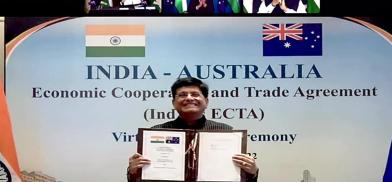India has a deal with Australia: Will it be a precursor to more FTAs?
The ECTA with Australia will boost India’s confidence in signing similar trade pacts with the UK and EU, writes N. Chandra Mohan for South Asia Monitor

Largely due to the compulsions of boosting exports as an engine of growth, the Modi government in India has of late revamped its strategy for free trade agreements (FTAs). With the UAE, a Comprehensive Economic Partnership Agreement was recently signed. Shortly thereafter, an economic cooperation and trade agreement between India and Australia has been inked. This will be followed by a flurry of trade pacts with the UK, Gulf Cooperation Council (GCC), Canada and the European Union among others. The level of ambition in the deals with Australia and the UK for instance is only for early-harvest agreements or mini-FTAs for trade in a limited set of goods and services. Such deals typically entail tariff reductions on selected items while leaving out more sensitive areas.
India’s Economic Cooperation and Trade Agreement (ECTA) with Australia has been hailed as a “watershed moment” by Prime Minister Narendra Modi as it contributes to the stability of the Indo-Pacific region. This deal’s significance is that it will indeed help India’s evolving outreach to this bustling prosperous region. Not so long ago, due to its concerns over a China-led trading architecture, it walked out on the Regional Comprehensive Economic Partnership (RCEP), comprising the Association of Southeast Asian Nations together with China, Japan, South Korea, Australia and New Zealand. India is also reviewing its FTA with ASEAN, Japan and South Korea.
Australia is a middle power in the Indo-Pacific and has the natural resources that can power the robust India growth story.
For such reasons, the lower level of ambition in the ECTA is perhaps warranted. Besides China’s influence, India’s ambivalence regarding RCEP was also because its dairy industry and farmers were apprehensive of stiff competition in milk and milk products from Australia and New Zealand. Given this sensitivity, dairy items have been kept out of the deal.
Template for other FTAs
New Delhi has also offered only limited access in agriculture. India has also tied concessions to quantitative caps like allowing long staple Australian cotton at zero duty only for 300,000 bales. Similarly, oranges and mandarin have preferential access only up
to 13,000 tonnes. Australia, in turn, has secured preferential access to the Indian market for coal, aluminium and premium wines.
From India’s point of view, the ECTA’s most important takeaway is that its yoga instructors, chefs, students and STEM (science, technology, engineering and mathematics) graduates will have easier access to Australia. The latter has provided an annual quota for such professionals to enter as contractual service providers entitled to stay for a period up to four years. Extension of the ECTA to services, especially mode 4 movement of skilled professionals, is a major gain.
This could well be a template for India’s forthcoming trade talks with the UK and EU. The extremely limited progress in services trade, especially the movement of natural persons, has indeed been a major source of frustration for India in its FTA talks with ASEAN, for instance.
Indian IT stands to benefit
Australia has pledged greater access in about 135 sub-sectors and the most favoured nation (MFN) status in 120 sub-sectors. India has offered Australia market access in around 103 sub-sectors and MFN status in 31 sub-sectors from the 11 broad service sectors like business services, communication services, construction and related engineering services, according to the Financial Express.
India’s IT firms also stand to benefit as Australia has agreed to amend its domestic laws to stop taxing their offshore income, resulting in savings of $200 million every year. The upshot is that given India’s comparative advantages in services, gains from services trade offsets what it loses from deficits in goods trade as it has with Australia of $7.2 billion.
Considering India’s evolving stakes in the Indo-Pacific region, there is a warrant for a higher level of ambition to ensure that its early harvest agreement with Australia graduates into a full-fledged FTA. Australia has much to offer a rising power like India,
notably, access to raw materials needed for its growing economy. But negotiations entail a process of give and take for greater access to each other’s markets. If India seeks greater market access, it must also allow partners to sell more of its goods and
services. Trade thus can be a win-win situation for both partners. But a higher level of
ambition may not be easy for India, according to economists like Professor Amita Batra of the Jawaharlal Nehru University.
As Australia is also a member of RCEP and Comprehensive and Progressive Agreement for Trans-Pacific Partnership, future talks on a higher-order deal will entail an equivalent level of preferential trade liberalization and regulatory reform which are somewhat difficult for India. But greater comfort levels in implementing the ECTA may well incentivize India to attempt deeper full-fledged FTAs. This may also help India in reconsidering its decision to stay out of the RCEP. Most certainly, this ETCA with Australia will boost India’s confidence in signing similar trade pacts with the UK and EU.
(The writer is an economics and business commentator based in New Delhi. His views are personal. He may be contacted at nchandramohan@rediffmail.com)










Post a Comment